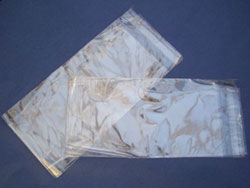The term cellophane derives from the words “cellulose” and “diaphane”, where the first is a composed unit of glucose and the second simply means transparent. The clear film is considered one of the oldest materialsto be used for packing candies, biscuits and other types of edibles. In the history of cellophane bags, the benefits that derived from the material have led to many different uses for them, and the quality standards have also improved over the years. Cellophane bags have been very useful based on the purpose of keeping the food safe and edible within the longest time possible. Certainly, the utility and features that cellophane bags possess remain unique among other food wrappers available in the market.
The Discovery of Cellophane
The history of cellophane bags started with the discovery that Jacques E. Brandenberger made around the year 1900. He was intrigued about finding out what material was capable of keeping liquids off a piece of table cloth instead of damping it. It all had started when the Swiss chemist observed how a bottle of wine was spilled over a restaurant’s table cloth, and he began to imagine how easy it would be if the cloth could repel liquids. While carrying out his own experiment, he sprayed a water proof chemical on a piece of cloth, and even though the fabric successfully repelled liquids it also became too stiff.
However, the history of cellophane bags started when Brandenberger noticed that the sprayed chemical could be separated from the cloth as a clear stiff film.After 10 years of hard work, Brandenberger made use of glycerin to soften the film and by 1912 he was able to make numerous types cellophanes bags with the use of his invented manufacturing machine.
Remarkable Timeline
The following timeline shows a briefdescription of the history of cellophane bags:
- 1900 – Jacques E. Brandenberger hd the idea of creating a material that could repel liquids.
- 1910 – Brandenberger was able to perfect the texture of the film by adding glycerin to make it soft.
- 1912 – The manufacturing machine was used by the Swiss chemist for the production of cellophane bags and the product was patented. La Cellophane SA Company was built and Brandenberger continued to work with his product.
- 1924 – Whitman was amazed with the history of cellophane bags so he made use of it as a candy wrapper in his company in the US. They became the largest buyer of cellophane.
- 1927 – Moisture-proof cellophane was created by chemist William Hale Charch. He was hired by Du Pont for their cellophane manufacturing plant in the US.
- 1928-1930 – The sales tripled and the increase of consumers since the history of the cellophane bags started was continuously booming.
Uses of Cellophane Bags
In the beginning of the history of cellophane bags, the majority of consumers were buying them to wrap different types of food, especially pastry and baked products. As time went by, the use of cellophane bags was widened and today it’s used to wrap cards, paper and other type of non-edible materials. Moreover, some types of batteries are manufactured with cellophane as their semi-permeable membrane. Cellophane is also used in the manufacturing of other materials, such as adhesive tape.

- Home
- Benefits Of Cellophane Bags
- Biodegradable Cellophane Bags
- Bulk Cellophane Bags
- Buy Cellophane Bags
- Candy Cellophane Bags
- Cellophane Art Bags
- Cellophane Bags Faqs
- Cellophane Bags
- Cheap Cellophane Bags
- Compostable Cellophane Bags
- Considerations Cellophane Bags
- Cupcake Cellophane Bags
- Custom Cellophane Bags
- Custom Printed Cellophane Bags
- Customized Cellophane Bags
- Decorative Cellophane Bags
- Different Colors Of Cellophane Bags
- Different Shapes Of Cellophane Bags
- Different Sizes Of Cellophane Bags
- Disadvantages Of Cellophane Bags
- Discount Cellophane Bags
- Discovered It Cellophane Bags
- Expert Insight Into Cellophane Bags
- Facts About Cellophane Bags
- Features Of Cellophane Bags
- Function Of Cellophane Bags
- Gift Basket Cellophane Bags
- History Of The Cellophane Bags
- How Are Cellophane Bags Used
- Misconceptions About Cellophane Bags
- Party Cellophane Bags
- Paw Print Cellophane Bags
- Personalized Cellophane Bags
- Personalized Cellophane Candy Bags
- Plastic Cellophane Bags
- Polka Dot Cellophane Bags
- Potential Of Cellophane Bags
- Printed Cellophane Bags Wholesale
- Printed Cellophane Bags
- Resealable Cellophane Bags
- Sealable Cellophane Bags
- Self Adhesive Cellophane Bags
- Warning For Cellophane Bags
- What Are Cellophane Bags Used For
- When Are Cellophane Bags Used
- Where Are Cellophane Bags Used
- Where To Buy Cellophane Bags
- Who Invented The Cellophane Bag
- Wholesale Cellophane Bags
- Wholesale Cellophane Gift Bags
- Why Are Cellophane Bags Used
- Cellophane Bags
- Cellophane Bags For Occassions
- Clear Cellophane Bags
- Colored Cellophane Bags
- Cone Shaped Cellophane Bags
- Extra Large Cellophane Bags
- Food Cellophane Bags
- Large Cellophane Bags
- Small Cellophane Bags
- Types Of Cellophane Bags
- What Can Cellophane Bags Be Used For
